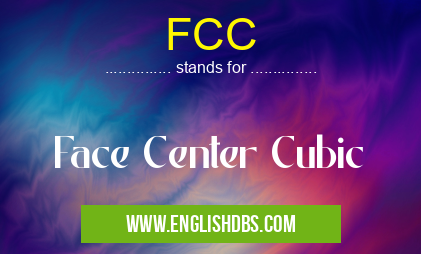What does FCC mean in UNCLASSIFIED
FCC stands for Face Center Cubic and refers to a specific crystal structure found in materials. In this structure, atoms are arranged in a way that forms a cube with atoms at each corner and in the center of each face.

FCC meaning in Unclassified in Miscellaneous
FCC mostly used in an acronym Unclassified in Category Miscellaneous that means Face Center Cubic
Shorthand: FCC,
Full Form: Face Center Cubic
For more information of "Face Center Cubic", see the section below.
Characteristics of FCC Structure
- Cubic Shape: The FCC structure has a repeating pattern of cubes.
- Atom Arrangement: Atoms are located at the corners (8 atoms) and at the center of each face (6 atoms).
- Close Packing: FCC is a close-packed structure, meaning that the atoms are packed tightly together.
- High Symmetry: FCC has a high degree of symmetry, with threefold, fourfold, and sixfold rotational axes.
- Common Materials: Some common materials with an FCC structure include copper, silver, gold, aluminum, and nickel.
Properties of FCC Materials
- Ductility: FCC materials are generally ductile, meaning they can be stretched or deformed without breaking.
- Malleability: They are also malleable, meaning they can be hammered or rolled into thin sheets.
- High Strength: FCC materials often have high strength, making them suitable for structural applications.
- Thermal and Electrical Conductivity: FCC materials generally have good thermal and electrical conductivity.
Applications of FCC Materials
FCC materials are used in a wide range of applications, including:
- Electronics: Copper and gold are used in electrical wiring and circuits.
- Construction: Steel (an alloy with an FCC structure) is used in buildings, bridges, and other structures.
- Jewelry: Gold, silver, and platinum (another FCC metal) are used in jewelry and other decorative items.
- Automotive: Aluminum is used in car bodies and engine parts.
Essential Questions and Answers on Face Center Cubic in "MISCELLANEOUS»UNFILED"
What is Face Center Cubic (FCC)?
FCC is a crystal structure in which atoms are arranged in a cubic lattice with atoms located at each corner and in the center of each face. This structure is also known as a cubic close-packed (CCP) structure. FCC is one of the most common crystal structures found in metals, such as aluminum, copper, gold, and silver.
Why is FCC a common crystal structure for metals?
FCC is a close-packed structure, which means that the atoms are arranged as efficiently as possible. This close packing results in a high packing density, which gives FCC metals their strength and ductility. Additionally, the FCC structure allows for easy dislocation movement, which contributes to the malleability of FCC metals.
What are some examples of FCC metals?
Some common FCC metals include:
- Aluminum
- Copper
- Gold
- Silver
- Nickel
- Platinum
- Lead
How does FCC differ from other crystal structures?
FCC differs from other crystal structures in the way that its atoms are arranged. For example, in a body-centered cubic (BCC) structure, atoms are located at each corner and in the center of the cube, while in a hexagonal close-packed (HCP) structure, atoms are arranged in a hexagonal pattern with layers stacked in an ABAB sequence.
What are the properties of FCC metals?
FCC metals generally have the following properties:
- High strength and ductility
- Good electrical and thermal conductivity
- High melting points
- Face-centered cubic crystal structure
Final Words: The FCC crystal structure is a common and important structure found in many materials. It imparts specific properties such as ductility, malleability, strength, and conductivity, which make these materials suitable for a wide range of applications.
FCC also stands for: |
|
| All stands for FCC |
